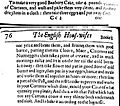The English Huswife facts for kids

Title page
|
|
| Author | Gervase Markham |
|---|---|
| Country | England |
| Subject | Remedies, Cookery |
| Genre | Books for women |
| Publisher | Roger Jackson |
|
Publication date
|
1615 |
The English Huswife is a famous book from 1615. It was written by Gervase Markham and published in London. The book is all about cooking and home remedies from England.
It was a huge success when it came out! The book was printed nine times and reprinted at least twice by 1683. It was part of a two-book set called Countrey Contentments. The other book was about farming and fun activities.
Even though Markham said he didn't write all the recipes himself, he did change them. He made them fit the tastes of his time, especially adding sweet and sour flavors. This book also has what might be the first ever published recipe for Banbury cake.
Contents
About the Author: Gervase Markham
Gervase Markham was born around 1568. He was the third son of Sir Robert Markham. Gervase was a soldier who fought in the Low Countries (modern-day Netherlands and Belgium). He also served as a captain in Ireland.
Markham wrote many, many books on different topics. He wrote so much that his booksellers made him promise in 1617 not to write about certain subjects anymore!
The Book's Big Idea
The English Huswife was the second part of a larger work. The full title was very long! It talked about many skills needed for a complete woman. This included medicine, cooking, making fancy foods, and even how to handle wool and flax. It also covered dairy, brewing, and baking.
The first part of the set was called The Husbandmans Recreations. It focused on riding horses, hunting, and other outdoor sports.
How the Book Was Written
Markham starts his book by saying he's not an expert in "Hus-wifery" (housekeeping). He explains that he found an "approved Manuscript" (a trusted handwritten book). This manuscript belonged to an "honorable Personage," a high-ranking lady. She was known for many of the skills described in the book. Markham never says who this lady was.
The recipes in the book are written in a simple way. Each recipe is a paragraph. The name of the dish is written in italics next to it, like "Sauce for veale". Sometimes, the title tells you what to make, like "To make ginger bread".
The recipes usually don't list ingredients or exact amounts. For example, a pancake recipe asks for "two or three Eggs" and "a pretty quantity of fair running water." It also says to add "fine Wheat-flower" until it's "as thick as you think good." The book suggests using water instead of milk for crispier pancakes. It also mentions adding sweet spices like cloves and cinnamon.
Cooking times and heat levels are rarely given. The pancake recipe just says "make them brown." However, the book does explain how to tell when meat is perfectly roasted. It says to watch for the meat shrinking from the spit. Also, the gravy should be clear, not bloody.
What's Inside the Book
The book has 128 pages and starts with a "Table" (table of contents). This table lists all the different topics and recipes. The book is divided into chapters, but the table of contents lists the page headers instead of chapter names.
Here are the main topics covered:
- Chapter 1: House-hold Physicke (Home Medicine)
- Chapter 2: Skill in Cookery (Cooking Skills)
- Banquetting Stuffe (Fancy Party Foods)
- Distillation (Making liquids like perfumes)
- Muske-balls, &c. (Making scented items)
- Chapter 3: Of Woolle, Hempe, Flaxe and Cloth (Working with fabrics)
- Dying of Wooll (Coloring wool)
- Skill in Hempe, Flaxe, &c. (Working with hemp and flax)
- Chapter 4: Of Dairies, Butter, Cheese (Making dairy products)
- Chapter 5: Of the office of the Brew-house, and the Bake-house (Brewing and Baking)
- Brewing (Making drinks like beer)
- Baking (Making bread and pastries)
Different Printings of the Book
The English Huswife was very popular, so it was printed many times. Here are some of its editions:
- 1615: The very first edition.
- 1631: The fourth edition.
- 1637: It was reprinted.
- 1649: The fifth edition. This one was reprinted in 1986.
- 1653: It was reprinted again.
- 1656: The sixth edition.
- 1660: The seventh edition.
- 1664: The eighth edition.
- 1683: The ninth edition.
Images for kids
-
Delicious Banbury cakes.



